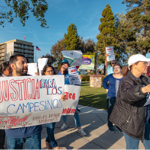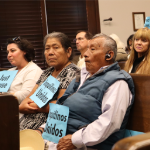Environmental Justice for the Santa Maria Valley

For generations, communities of color have been deprived of accessible green spaces due to lack of investment and environmental racism.
In 2022, CAUSE youth leaders in Santa Maria achieved a major victory by bringing the community together to show the support and benefits of investing and creating accessible outdoor spaces. The Santa Maria Valley has limited public green spaces compared to wealthier communities nearby like Santa Barbara and San Luis Obispo. CAUSE’s Santa Maria youth committee decided to get involved in winning a commitment from the County Board of Supervisors to extend the Santa Maria river levee trail to Guadalupe to connect to the coast and double the amount of public trails in northern Santa Barbara County.
The most difficult hurdle was convincing the Board of Supervisors to invest in the project. We gathered surveys and petitions, attended meetings with policy makers, hosted community events, and mobilized Santa Maria residents to public hearings to convince the supervisors to back the project. Through engaging over 500 residents – with the leadership of 50 Santa Maria youth – we established significant public support to invest in new green spaces.
Despite community support, the trail extension was repeatedly delayed because of powerful political opposition. The agriculture industry is the major driver of the Santa Maria Valley’s economy and has incredible influence over the county’s politics. The agriculture industry mobilized in opposition to extending the trail for the community because it would require increasing pesticide buffer zones along the river. The opposition spread a false narrative that the new outdoor space would increase theft and vandalism nearby. This kind of rhetoric is rarely used to describe trail users in more affluent communities, criminalized our immigrant farmworker community in the Santa Maria Valley. CAUSE youth courageously fought back against this mindset that only serves to reinforce social inequalities, depriving the community of accessible outdoor spaces while protecting the bottom line of the wealthy.
In response, we coordinated a regional coalition of 15 community organizations and allies to submit letters to local leaders laying out the need for more equitable investment in outdoor spaces in Santa Barbara County. We informed and engaged the public, from op-eds in local newspapers to a social media education campaign, to urge the county to put people over profits.
Through the community’s leadership and efforts – from petition gathering, to mobilizing residents, engaging the media, and viral social media content – that spanned over a year, we were able to convince the entire board of supervisors, including the two who originally opposed the proposal, to support and invest in the riverbed trail extension. Despite the powerful opposition the supervisors could no longer ignore the community’s wants and needs based on the display of support so they unanimously voted to allocate $1.5 million to design and plan the project. In this effort to deliver environmental justice for Santa Maria, CAUSE leaders have and will continue to center the community to ensure the new outdoor space will meet what the region wants and needs. Engaging the community will extend throughout the approval process and will continue through the development of the Santa Maria riverbed trail expansion.
The environmental justice movement, organized by communities of color most impacted by pollution and extractive industry, has grown in political power and recognition – and we’ll just keep getting stronger and more powerful through our grassroots efforts. CAUSE will continue to support this movement through campaigns to create a sustainable environment and deliver justice for communities disproportionately affected by pollution and climate change.
Our work to deliver environmental justice is alive and well in all five of our chapter cities. We are hard at work fighting air pollution from large diesel trucks and toxic power plants, making schools resilient to extreme weather, and protecting farmworkers impacted by climate disasters..














